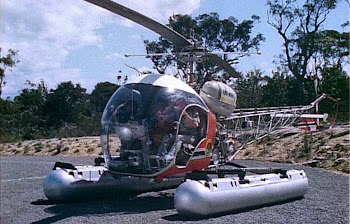Flying on a cloudless night, with the landscape illuminated by an almost full moon, the crew of Avro Anson W1655 might well have felt some serenity. At least, until both engines suddenly stopped. It was 8.50 p.m. on a Monday, 30th March 1942.

Flying the Anson was twenty-one year old Robert Bennett Lasscock of Perth (West Australia). Formerly a bank officer, he had joined the RAAF exactly one year earlier. Posted from Sydney to No.8 Service Flying Training School at Bundaberg in south-east Queensland, Lasscock was completing a circuit of the aerodrome at the time – after returning from a night training flight. Although he had rehearsed many times for such a predicament, no amount of training could have replicated the fear and apprehension he must have surely felt then.

Having only arrived in Bundaberg five days earlier, he would have been aware at least that the sugar cane fields surrounding the aerodrome were relatively flat – increasing his chances of surviving the inevitable crash landing.1Lasscock Robert Bennett : Service Number – 406722, NAA (Canberra): A9300, LASSCOCK R B, ID 5250842, https://recordsearch.naa.gov.au/SearchNRetrieve/Interface/ViewImage.aspx?B=5250842
Meanwhile, sugar cane farmer Colin Toft had been lying in bed at Avoca, two-and-a-half miles west of Bundaberg, when he noticed two planes flying some distance from the house, one of which “suddenly appeared to lose altitude” crashing nearby in his father’s paddock.2Bill Kerr, “Toft, Colin Bramwell (1921–1990),” Australian Dictionary of Biography, https://adb.anu.edu.au/biography/toft-colin-bramwell-15645. As Colin later recounted in his Police Statement, the plane’s engines “did not appear to be functioning properly.” He immediately raced by car for the ambulance and the police.

In a separate police statement, Colin’s father Joseph also reported having seen “the plane flying low and …heading in the direction of his house” when it “suddenly swerved and struck the ground.” While awaiting the ambulance’s arrival one of the plane’s crew had remarked to Joseph that “one of the controls [had] failed but we did the best we could.”3Sub-Inspector J Osborne (Bundaberg Station) to Queensland Police Commissioner, Report Ref.3013, 30 March 1942, Queensland State Archives: Agency Control Number
1861M, Item ID ITM320040, https://www.archivessearch.qld.gov.au/items/ITM320040.
Half an hour after the crash, Sub-Inspector James Osborne at the local Police Station answered a call from Bundaberg resident Frank Christensen, informing him that an Air Force aeroplane had just crashed in Toft’s paddock at Avoca—about three miles west of Bundaberg. Colin Toft also arrived at the same time, adding that he had already notified the Bundaberg Ambulance Brigade while on his way to the Police Station.

By the time the party of four policemen reached the crash scene, 100 yards from the Toft’s residence, the three crew were already being treated by ambulance personnel. All onboard the plane (viz. pilot, co-pilot and passenger) survived the crash, sustaining shock and laceration injuries.
In the Preliminary Report prepared the following day Lasscock (pilot) was charged with “Carelessness and disobedience of orders,” due to his “failure to change to full inner tanks when outer tanks became exhausted.”4Preliminary Report No.889 (1941-42), Avro Anson Accidents Part 12, NAA (Canberra): A9845, 70, ID 7127542, https://recordsearch.naa.gov.au/SearchNRetrieve/NAAMedia/ShowImage.aspx?B=7127542&S=27&T=P&R=0. Also injured was the co-pilot nineteen year old LAC Frank Alexander (Alec) Badgery (412565), formerly a station manager from Cumnock in New South Wales.5Badgery Frank Alexander : Service Number – 412565, NAA: A9300, Badgery F A, ID 5380128, https://recordsearch.naa.gov.au/SearchNRetrieve/Interface/ViewImage.aspx?B=5380128. The Flying School’s daily log however, which would have been written up around the same time, makes no such adverse findings against the pilot, noting only that “the pilot lost control.”6https://recordsearch.naa.gov.au/SearchNRetrieve/NAAMedia/ShowImage.aspx?B=1360155&T=P&S=696. What this log does reveal however, is that Lasscock was carrying an “unauthorised” passenger at the time of the accident. Twenty-three year-old AC1 Eric Keith Baldock (43811), a Brisbane shoemaker, had discharged from the Army in mid-October 1941 before re-enlisting with the Air Force the following day. Although forbidden by Air Force regulations it was commonplace then, especially on training bases, for crews to occasionally risk the carriage non-flying personnel. Doing so at night, further diminished the chances of being caught out. There is nothing in Baldock’s Conduct Record to indicate however that he, or the pilot (Lasscock) were ever disciplined following this incident.7Baldock Eric Keith: Service Number – 43811, NAA (Canberra): A9301, 43811, ID 4595541, https://recordsearch.naa.gov.au/SearchNRetrieve/Gallery151/dist/JGalleryViewer.aspx?B=4595541&S=8&N=62&R=0.

This in fact was the first of several lucky escapes for Lasscock who, a year later, survived another forced (daylight) landing when in late April 1943 the Anson he was flying also suffered an “alleged engine failure,” 10 miles north-west of Bundaberg.8Preliminary Report No.964 (1942-43), Avro Anson Accidents Part 5, NAA (Canberra): A9845, 63, ID 7127535, https://recordsearch.naa.gov.au/SearchNRetrieve/NAAMedia/ShowImage.aspx?B=7127535&S=28&T=P&R=0. Lasscock later served operationally with 31 Squadron based at Morotai, Indonesia, and it was while he was taxying a Beaufighter (A19-181) there in late August 1944 that his brakes failed, causing the aircraft to collide with a pole and sustain major damage.9F/Lt. L. J. Joseph to Secretary, Air Board, Confirmatory Memorandum 000091, ? August 1944, NAA (Canberra): A9845, 21, ID, 6950475, https://recordsearch.naa.gov.au/SearchNRetrieve/NAAMedia/ShowImage.aspx?B=6950475&T=P&S=4.
Alec Badgery’s flying career, on the other hand, couldn’t have been more different. He served operationally in Europe, flying Halifax bombers for much of 1944 with the Canadian Air Force’s No, 431 Squadron. In September 1944 he was awarded a Distinguished Flying Cross, the citation mentioning that he’d flown numerous sorties to Berlin and the Ruhr, while displaying “coolness, courage and determination.”10Commonwealth of Australia Gazette, 21 September 1944, Issue No.190, 2179, http://nla.gov.au/nla.news-article23275611.; https://www.rcafassociation.ca/heritage/search-awards/?search=badgery&searchfield=lastname&type=all. Having survived their crash landing at Avoca, all three on board the Anson that night went on to survive the war.
Thanks to Lyn Mergard who generously shared her recollections and photographs, first published to the Facebook Group, Bundaberg: Remember When, on 28 January 2022: 10.22.









![This unusual piece of early Australian [aeronautical] silverware realized $4,700 at auction in Sydney earlier this week, selling for more than three times its estimated reserve.](https://assets.aeromuseums.org/2015/09/1920-N.S.W.-Aerial-Derby-Cup-219x300.jpg)
















